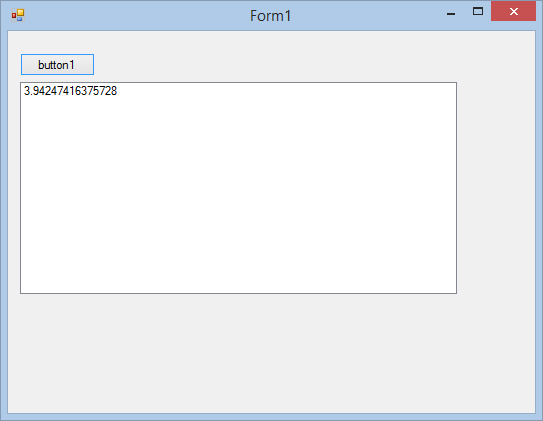Introduction
Hello, and welcome to my article. Sometimes, I wonder where all my ideas for my articles come from; at least I now know why I cannot sleep most evenings. My brain doesn’t switch off. It is a blessing and a curse.
Today, you will learn how to make use of the Shannon Entropy equation to work out probabilities in your .NET applications.
Entropy
Entropy can be defined in the context of a probabilistic model. For example: A coin flip has an entropy of 1 bit per coin flip. A string that always generates a long sequence of As has an entropy of 0, because the next character in the string will always be an ‘A’.
Shannon Entropy
Claude Shannon’s entropy measures information contained in a message; for example: redundancy in language structure, and information about the occurrence frequencies of letter or word pairs, and so on. Shannon entropy provides a way to determine the average minimum number of bits needed to encode a string, based on the frequency of the symbols inside the string.
Our Project
Create a new C# or Visual Basic.NET Windows Forms project. Once the default form has loaded, add one Button and one ListBox to it.
Code
Add a new Class to your project and name it ShannonEntropy; then, add the necessary NameSpaces.
C#
using System; using System.Collections.Generic; using System.IO; using System.Linq;
VB.NET
Imports System Imports System.Collections.Generic Imports System.IO Imports System.Linq
Add the following fields.
C#
SortedList<byte, int> slTimeSymbolAppears; SortedList<byte, double> slEntropy; double dblEntropy; bool blnUsed; int iSize;
VB.NET
Private slTimeSymbolAppears As SortedList(Of Byte, Integer) Private slEntropy As SortedList(Of Byte, Double) Private dblEntropy As Double Private blnUsed As Boolean Private iSize As Integer
slTimeSymbolAppears contains each occurrence of the desired symbol. dblEntropy will contain the result of the process and blnUsed is True or False depending on whether or not a symbol has been used. Add the Properties.
C#
public int Size
{
get
{
return iSize;
}
private set
{
iSize = value;
}
}
public int Unique
{
get
{
return slTimeSymbolAppears.Count;
}
}
public double Entropy
{
get
{
return GetEntropy();
}
}
public Dictionary<byte, int> Distribution
{
get
{
return SortedDistribution();
}
}
public Dictionary<byte, double> Probability
{
get
{
return SortedProbability();
}
}
VB.NET
Public Property Size As Integer
Get
Return iSize
End Get
Private Set(ByVal value As Integer)
iSize = value
End Set
End Property
Public ReadOnly Property Unique As Integer
Get
Return slTimeSymbolAppears.Count
End Get
End Property
Public ReadOnly Property Entropy As Double
Get
Return GetEntropy()
End Get
End Property
Public ReadOnly Property Distribution As Dictionary(Of Byte, _
Integer)
Get
Return SortedDistribution()
End Get
End Property
Public ReadOnly Property Probability As Dictionary(Of Byte, _
Double)
Get
Return SortedProbability()
End Get
End Property
Add the reset of the Functions and the Constructor.
C#
public byte GreatestDistribution()
{
return slTimeSymbolAppears.Keys[0];
}
public byte GreatestProbability()
{
return slEntropy.Keys[0];
}
public double SymbolDistribution(byte bSymbol)
{
return slTimeSymbolAppears[bSymbol];
}
public double SymbolEntropy(byte bSymbol)
{
return slEntropy[bSymbol];
}
public Dictionary<byte, int> SortedDistribution()
{
List<Tuple<int, byte>> lstEntries = new
List<Tuple<int, byte>>();
foreach (KeyValuePair<byte, int> e in slTimeSymbolAppears)
{
lstEntries.Add(new Tuple<int, byte>(e.Value, e.Key));
}
lstEntries.Sort();
lstEntries.Reverse();
Dictionary<byte, int> dicResult = new
Dictionary<byte, int>();
foreach (Tuple<int, byte> e in lstEntries)
{
dicResult.Add(e.Item2, e.Item1);
}
return dicResult;
}
public Dictionary<byte, double>SortedProbability()
{
List<Tuple<double, byte>> lstEntries = new
List<Tuple<double, byte>>();
foreach (KeyValuePair<byte, double> e in slEntropy)
{
lstEntries.Add(new Tuple<double, byte>(e.Value, e.Key));
}
lstEntries.Sort();
lstEntries.Reverse();
Dictionary<byte, double> dicResult = new
Dictionary<byte, double>();
foreach (Tuple<double, byte> e in lstEntries)
{
dicResult.Add(e.Item2, e.Item1);
}
return dicResult;
}
public double GetEntropy()
{
if (!blnUsed)
{
return dblEntropy;
}
dblEntropy = 0;
slEntropy = new SortedList<byte, double>();
foreach (KeyValuePair<byte, int> e in slTimeSymbolAppears)
{
slEntropy.Add(e.Key, (double)slTimeSymbolAppears[e.Key] /
(double)iSize);
}
foreach (KeyValuePair<byte, double> e in slEntropy)
{
dblEntropy += e.Value * Math.Log((1 / e.Value), 2);
}
blnUsed = false;
return dblEntropy;
}
public void GetBytes(byte[] bBytes)
{
if (bBytes.Length < 1 || bBytes == null)
{
return;
}
blnUsed = true;
iSize += bBytes.Length;
foreach (byte bt in bBytes)
{
if (!slTimeSymbolAppears.ContainsKey(bt))
{
slTimeSymbolAppears.Add(bt, 1);
continue;
}
slTimeSymbolAppears[bt]++;
}
}
public void GetBytes(string strBytes)
{
GetBytes(StringToByteArray(strBytes));
}
byte[] StringToByteArray(string strInput)
{
char[] c = strInput.ToCharArray();
IEnumerable<byte> b = c.Cast<byte>();
return b.ToArray();
}
void Clear()
{
blnUsed = true;
dblEntropy = 0;
iSize = 0;
slTimeSymbolAppears = new SortedList<byte, int>();
slEntropy = new SortedList<byte, double>();
}
public ShannonEntropy(string fileName)
{
Clear();
if (File.Exists(fileName))
{
GetBytes(File.ReadAllBytes(fileName));
GetEntropy();
SortedDistribution();
}
}
public ShannonEntropy()
{
Clear();
}
VB.NET
Public Function GreatestDistribution() As Byte
Return slTimeSymbolAppears.Keys(0)
End Function
Public Function GreatestProbability() As Byte
Return slEntropy.Keys(0)
End Function
Public Function SymbolDistribution(ByVal bSymbol As Byte) _
As Double
Return slTimeSymbolAppears(bSymbol)
End Function
Public Function SymbolEntropy(ByVal bSymbol As Byte) As Double
Return slEntropy(bSymbol)
End Function
Public Function SortedDistribution() As Dictionary(Of Byte, _
Integer)
Dim lstEntries As List(Of Tuple(Of Integer, Byte)) = New _
List(Of Tuple(Of Integer, Byte))()
For Each e As KeyValuePair(Of Byte, Integer) In _
slTimeSymbolAppears
lstEntries.Add(New Tuple(Of Integer, Byte)(e.Value, _
e.Key))
Next
lstEntries.Sort()
lstEntries.Reverse()
Dim dicResult As Dictionary(Of Byte, Integer) = New _
Dictionary(Of Byte, Integer)()
For Each e As Tuple(Of Integer, Byte) In lstEntries
dicResult.Add(e.Item2, e.Item1)
Next
Return dicResult
End Function
Public Function SortedProbability() As Dictionary(Of Byte, _
Double)
Dim lstEntries As List(Of Tuple(Of Double, Byte)) = New _
List(Of Tuple(Of Double, Byte))()
For Each e As KeyValuePair(Of Byte, Double) In slEntropy
lstEntries.Add(New Tuple(Of Double, Byte)(e.Value, e.Key))
Next
lstEntries.Sort()
lstEntries.Reverse()
Dim dicResult As Dictionary(Of Byte, Double) = New _
Dictionary(Of Byte, Double)()
For Each e As Tuple(Of Double, Byte) In lstEntries
dicResult.Add(e.Item2, e.Item1)
Next
Return dicResult
End Function
Public Function GetEntropy() As Double
If Not blnUsed Then
Return dblEntropy
End If
dblEntropy = 0
slEntropy = New SortedList(Of Byte, Double)()
For Each e As KeyValuePair(Of Byte, Integer) In _
slTimeSymbolAppears
slEntropy.Add(e.Key, CDbl(slTimeSymbolAppears(e.Key)) / _
CDbl(iSize))
Next
For Each e As KeyValuePair(Of Byte, Double) In slEntropy
dblEntropy += e.Value * Math.Log((1 / e.Value), 2)
Next
blnUsed = False
Return dblEntropy
End Function
Public Sub GetBytes(ByVal bBytes As Byte())
If bBytes.Length < 1 OrElse bBytes Is Nothing Then
Return
End If
blnUsed = True
iSize += bBytes.Length
For Each bt As Byte In bBytes
If Not slTimeSymbolAppears.ContainsKey(bt) Then
slTimeSymbolAppears.Add(bt, 1)
Continue For
End If
slTimeSymbolAppears(bt) += 1
Next
End Sub
Public Sub GetBytes(ByVal strBytes As String)
GetBytes(StringToByteArray(strBytes))
End Sub
Private Function StringToByteArray(ByVal strInput As String) _
As Byte()
Dim c As Char() = strInput.ToCharArray()
Dim b As IEnumerable(Of Byte) = c.Cast(Of Byte)()
Return b.ToArray()
End Function
Private Sub Clear()
blnUsed = True
dblEntropy = 0
iSize = 0
slTimeSymbolAppears = New SortedList(Of Byte, Integer)()
slEntropy = New SortedList(Of Byte, Double)()
End Sub
Public Sub New(ByVal fileName As String)
Clear()
If File.Exists(fileName) Then
GetBytes(File.ReadAllBytes(fileName))
GetEntropy()
SortedDistribution()
End If
End Sub
Public Sub New()
Clear()
End Sub
Add the code for your Form.
C#
namespace ShannonEntropy_C
{
public partial class Form1 : Form
{
ShannonEntropy se = new
ShannonEntropy(@"C:\\Temp\\TestFile.txt");
public Form1()
{
InitializeComponent();
}
private void button1_Click(object sender, EventArgs e)
{
double ge = se.GetEntropy();
listBox1.Items.Add(ge.ToString());
}
}
}
VB.NET
Public Class Form1
Private se As ShannonEntropy = New _
ShannonEntropy("C:\Temp\TestFile.txt")
Private Sub button1_Click(sender As Object, e As EventArgs) _
Handles button1.Click
Dim ge As Double = se.GetEntropy()
listBox1.Items.Add(ge.ToString())
End Sub
End Class
When you click the button, it will calculate and display the Entropy. I have included the Textfile, but keep in mind that it must be referenced properly and you might not have a Temp folder on your disk.
Figure 1 shows the result.
Figure 1: Running
Conclusion
In this article, you have learned how useful entropy can be in determining repetitive values. Until next time, happy coding!



